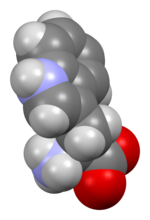Homogentisic acid (2,5-dihydroxyphenylacetic acid) is a phenolic acid usually found in Arbutus unedo (strawberry-tree) honey. It is also present in the...
5 KB (398 words) - 23:43, 5 August 2024
Alkaptonuria (category Amino acid metabolism disorders)
accumulates an intermediate substance called homogentisic acid in the blood and tissues. Homogentisic acid and its oxidized form alkapton are excreted...
19 KB (2,168 words) - 14:37, 19 October 2024
from the oxidative dimerization of homogentisic acid. It has been both widely and falsely reported that hipposudoric acid colors hippo milk pink. This is...
4 KB (220 words) - 16:07, 21 October 2024
Oxaloacetic acid (also known as oxalacetic acid or OAA) is a crystalline organic compound with the chemical formula HO2CC(O)CH2CO2H. Oxaloacetic acid, in the...
12 KB (1,159 words) - 10:09, 7 July 2024
gene encoding a 4-hydroxyphenylpyruvic acid dioxygenase-like protein that directs the production of homogentisic acid and an ochronotic pigment in Escherichia...
3 KB (169 words) - 12:38, 21 August 2024
Glutamic acid (symbol Glu or E; the anionic form is known as glutamate) is an α-amino acid that is used by almost all living beings in the biosynthesis...
35 KB (3,237 words) - 17:07, 11 September 2024
Homogentisate 1,2-dioxygenase (redirect from Homogentisic acid oxidase)
Homogentisate 1,2-dioxygenase (homogentisic acid oxidase, homogentisate oxidase, homogentisicase) is an enzyme which catalyzes the conversion of homogentisate...
6 KB (602 words) - 14:28, 26 August 2023
Lysine (redirect from 2,6-diaminohexanoic acid)
Lysine (symbol Lys or K) is an α-amino acid that is a precursor to many proteins. Lysine contains an α-amino group (which is in the protonated −NH+3 form...
68 KB (7,547 words) - 20:48, 20 October 2024
Ochronosis (category Amino acid metabolism disorders)
Ochronosis is a syndrome caused by the accumulation of homogentisic acid in connective tissues. The condition was named after the yellowish (ocher-like)...
11 KB (1,304 words) - 16:35, 26 October 2024
Anthranilic acid is an aromatic acid with the formula C6H4(NH2)(CO2H) and has a sweetish taste. The molecule consists of a benzene ring, ortho-substituted...
13 KB (1,057 words) - 18:06, 15 August 2023
Pyruvic acid (CH3COCOOH) is the simplest of the alpha-keto acids, with a carboxylic acid and a ketone functional group. Pyruvate, the conjugate base, CH3COCOO−...
16 KB (1,231 words) - 13:44, 2 November 2024
Glycine (redirect from Aminoethanoic acid)
/ˈɡlaɪsiːn/ ) is an amino acid that has a single hydrogen atom as its side chain. It is the simplest stable amino acid (carbamic acid is unstable). Glycine...
40 KB (3,766 words) - 11:02, 30 October 2024
3-Phosphoglyceric acid (3PG, 3-PGA, or PGA) is the conjugate acid of 3-phosphoglycerate or glycerate 3-phosphate (GP or G3P). This glycerate is a biochemically...
13 KB (1,003 words) - 11:07, 14 January 2024
reducing substances such as ascorbic acid, drugs (levodopa, contrast used in radiological procedures) and homogentisic acid (alkaptonuria) creates a false positive...
8 KB (904 words) - 06:55, 15 October 2024
Acne (section Azelaic acid)
discoloration and connective tissue damage from the accumulation of homogentisic acid). Combination therapy—using medications of different classes together...
167 KB (18,113 words) - 23:32, 3 November 2024
Fumaric acid or trans-butenedioic acid is an organic compound with the formula HO2CCH=CHCO2H. A white solid, fumaric acid occurs widely in nature. It...
12 KB (967 words) - 04:30, 23 September 2024
Citrulline (redirect from 2-Amino-5-(carbamoylamino)pentanoic acid)
The organic compound citrulline is an α-amino acid. Its name is derived from citrullus, the Latin word for watermelon. Although named and described by...
11 KB (856 words) - 14:42, 29 July 2024
glycocyamine (guanidino acetate, synthesized in the kidney from the amino acids arginine and glycine) by S-adenosyl methionine. It is then transported in...
22 KB (2,387 words) - 03:45, 27 October 2024
β-Hydroxy β-methylbutyric acid (HMB), otherwise known as its conjugate base, β-hydroxy β-methylbutyrate, is a naturally produced substance in humans that...
106 KB (9,982 words) - 15:37, 7 January 2024
Methionine (redirect from 2-amino-4-(methylthio)butanoic acid)
M) (/mɪˈθaɪəniːn/) is an essential amino acid in humans. As the precursor of other non-essential amino acids such as cysteine and taurine, versatile compounds...
30 KB (3,080 words) - 18:02, 28 October 2024
L-Arginine L-pyroglutamate (category Alpha-Amino acids)
pirglutargine and arginine pidolate, is the l-arginine salt of pyroglutamic acid. Arginine pyroglutamate is a delivery form of arginine. l-Arginine l-pyroglutamate...
2 KB (77 words) - 16:54, 17 September 2023
Ornithine (redirect from 2,5-Diaminopentanoic acid)
Ornithine is a non-proteinogenic α-amino acid that plays a role in the urea cycle. Ornithine is abnormally accumulated in the body in ornithine transcarbamylase...
9 KB (819 words) - 03:44, 3 November 2024
Valine (redirect from Α-Aminoisovaleric acid)
Valine (symbol Val or V) is an α-amino acid that is used in the biosynthesis of proteins. It contains an α-amino group (which is in the protonated −NH3+...
14 KB (1,188 words) - 12:26, 29 October 2024
Tryptophan (redirect from (2S)-2-amino-3-(1H-indol-3-yl)propanoic acid)
or W) is an α-amino acid that is used in the biosynthesis of proteins. Tryptophan contains an α-amino group, an α-carboxylic acid group, and a side chain...
52 KB (5,315 words) - 22:39, 7 October 2024
γ-aminobutyraldehyde (GABAL), N-acetyl-γ-aminobutyric acid (N-acetyl-GABAL), and N-acetyl-γ-aminobutyric acid (N-acetyl-GABA), biotransformations mediated by...
23 KB (2,185 words) - 19:05, 30 September 2024
catalyzes the hydrolysis of S-D-lactoylglutathione to glutathione and D-lactic acid. It maintains exogenous antioxidants such as vitamins C and E in their reduced...
25 KB (2,681 words) - 12:59, 4 October 2024
Leucine (redirect from 2-amino-4-methylpentanoic acid)
(symbol Leu or L) is an essential amino acid that is used in the biosynthesis of proteins. Leucine is an α-amino acid, meaning it contains an α-amino group...
27 KB (4,132 words) - 00:11, 7 September 2024
Alanine (redirect from 2-Aminopropanoic acid)
α-alanine, is an α-amino acid that is used in the biosynthesis of proteins. It contains an amine group and a carboxylic acid group, both attached to the...
23 KB (2,182 words) - 18:28, 14 June 2024
Tyrosinemia type III (category Amino acid metabolism disorders)
dioxygenase converts a tyrosine byproduct called 4-hydroxyphenylpyruvate to homogentisic acid. Characteristic features of type III tyrosinemia include mild mental...
3 KB (160 words) - 22:59, 6 November 2023
Homocysteine (category Alpha-Amino acids)
(/ˌhoʊmoʊˈsɪstiːn/) or Hcy: is a non-proteinogenic α-amino acid. It is a homologue of the amino acid cysteine, differing by an additional methylene bridge...
25 KB (2,076 words) - 03:26, 16 September 2024


























